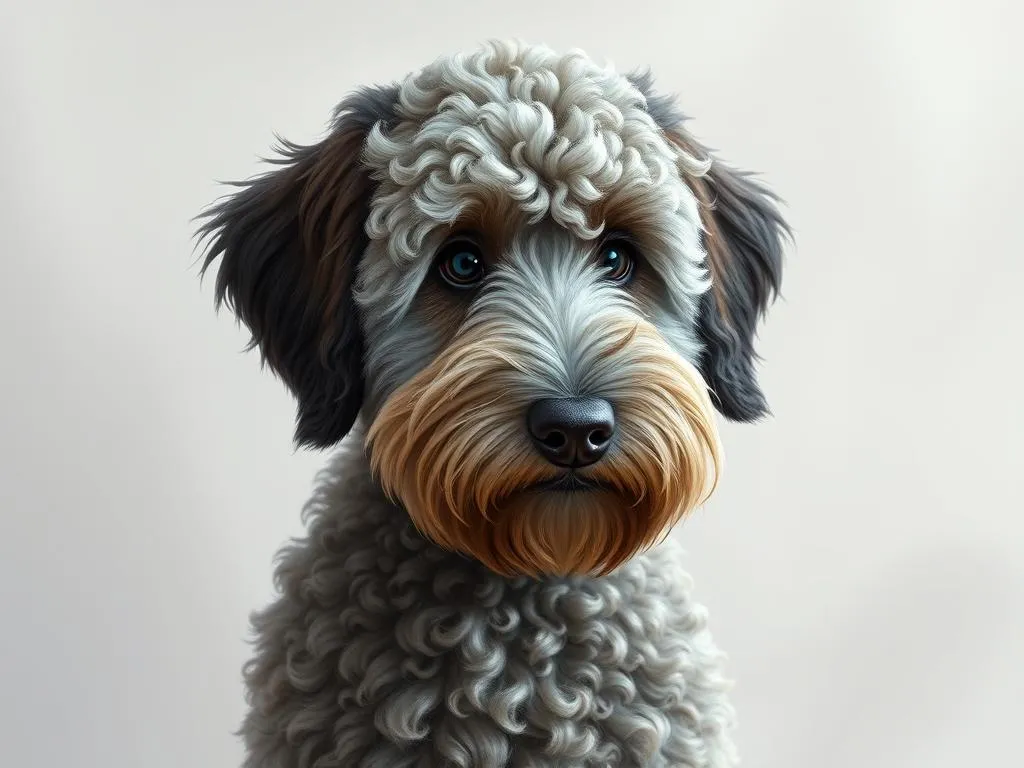
Introduction
When it comes to dog health care, grooming plays a crucial role, especially for breeds like Labradoodles. These delightful hybrids, a mix of Labrador Retrievers and Poodles, are known for their friendly temperament and hypoallergenic coats. However, their unique grooming needs require careful attention. Choosing the best brushes for Labradoodles is essential not only for their appearance but also for their overall health. This article will delve into the characteristics of Labradoodles, their grooming needs, the importance of regular grooming, and how to choose the right brushes for them.
Understanding Labradoodles
Breed Characteristics
Labradoodles are medium to large-sized dogs, averaging between 50 to 65 pounds. Their temperament is typically friendly and intelligent, making them great family pets. One of the most notable features of Labradoodles is their coat, which can vary widely in texture and length. Some have a curly, Poodle-like coat, while others may have a wavy or straight coat that resembles a Labrador.
Common health concerns for Labradoodles include hip dysplasia, ear infections, and skin allergies. Proper grooming, including the use of the best brushes for Labradoodles, can help mitigate some of these issues, particularly skin-related problems.
Grooming Needs
Regular grooming is essential for Labradoodles due to their unique coat types. Depending on their coat’s texture and length, grooming frequency may vary. Generally, they require brushing at least two to three times a week to prevent matting and to keep their skin healthy. Understanding their specific grooming needs can help maintain their beautiful coats and overall health.
Importance of Regular Grooming
Health Benefits
Grooming provides numerous health benefits for Labradoodles. Regular brushing helps prevent matting, which can lead to skin irritation and infections. Furthermore, grooming allows for the early detection of parasites, such as fleas and ticks, as well as skin conditions that may otherwise go unnoticed. Overall, consistent grooming contributes to better hygiene and health, ensuring your Labradoodle stays happy and healthy.
Emotional and Behavioral Benefits
Grooming is not just about physical appearance; it also has emotional benefits. Regular grooming sessions can strengthen the bond between the dog and owner, creating a trusting relationship. Additionally, many dogs find grooming to be a relaxing experience, helping to reduce stress and anxiety. For Labradoodles, which are known for their affectionate nature, grooming can be a delightful and comforting routine.
Choosing the Best Brushes for Labradoodles
Types of Brushes
When selecting the best brushes for Labradoodles, it’s essential to understand the different types available:
-
Slicker Brushes: These have fine, short wires close together on a flat surface, perfect for removing loose fur and preventing matting. They are great for curly and wavy coats but should be used gently to avoid skin irritation.
-
Pin Brushes: These brushes have rounded tips and are ideal for detangling the fur without damaging it. They work well for Labradoodles with longer coats.
-
Bristle Brushes: These are softer and better for smoothing and shining the coat. They help distribute natural oils, promoting healthy skin.
-
Undercoat Rakes: These are specifically designed to remove loose hair from the undercoat, which is particularly useful during shedding seasons.
Each brush has its advantages and disadvantages, and the best choice often depends on your Labradoodle’s specific coat type and grooming needs.
Recommended Brushes
Here are the top five recommended brushes for Labradoodles:
-
FURminator Undercoat DeShedding Tool: This tool effectively reduces shedding by reaching the undercoat while being gentle on the skin. It’s especially beneficial during shedding season.
-
Hertzko Self Cleaning Slicker Brush: This slicker brush features fine bristles that remove tangles and mats without pulling the dog’s hair. The self-cleaning feature makes it easy to maintain.
-
Pet Neat Pet Grooming Brush: This versatile brush is perfect for both long and short coats. It removes loose hair while also being gentle on the skin, making it a great all-round option.
-
GoPets Double-Sided Pin & Bristle Brush: This dual brush allows you to detangle with the pin side and smooth with the bristle side, making it perfect for maintaining Labradoodles’ coats.
-
Burt’s Bees for Pets Natural Deodorizing Spray: While not a brush, this spray is great for freshening up your Labradoodle’s coat after grooming sessions, ensuring they stay clean and pleasant-smelling.
Factors to Consider When Choosing a Brush
When selecting the right brush, consider the following factors:
-
Coat Length and Texture: Determine whether your Labradoodle has a curly, wavy, or straight coat, as this will influence the type of brush you should choose.
-
Dog’s Comfort and Sensitivity: Some dogs may have sensitive skin. It’s important to select brushes that are gentle and comfortable for your Labradoodle.
-
Ease of Cleaning and Maintenance: Choose brushes that are easy to clean and maintain, as this will encourage you to use them more frequently.
Grooming Techniques for Labradoodles
Brushing Techniques
Brushing your Labradoodle should be a rewarding experience. Here’s a step-by-step guide:
-
Choose the Right Time: Pick a time when your dog is calm, perhaps after a walk or play session.
-
Start Slowly: Introduce the brush gently, allowing your Labradoodle to sniff and get used to it.
-
Section the Coat: Divide the coat into manageable sections to ensure thorough grooming.
-
Brush in the Direction of Hair Growth: Start brushing from the head, moving toward the tail. Be gentle and avoid pulling on tangles.
-
Check for Mats: If you encounter a mat, use your fingers to gently separate it before brushing through it rather than forcing the brush through.
-
Reward Your Dog: After grooming, offer treats and praise to create a positive association with the grooming process.
Bathing and Drying
Bathing should be done every 4-6 weeks, or as needed. Overbathing can strip natural oils and lead to dry skin. Use a high-quality, dog-friendly shampoo.
After bathing, it’s crucial to dry your Labradoodle properly. Use a soft towel to absorb excess water, and if your dog is comfortable, consider using a blow dryer on a low setting. Always keep the dryer at a safe distance to avoid overheating.
Other Grooming Practices
-
Nail Trimming: This should be done every 3-4 weeks. Use a sharp nail clipper and be cautious not to cut too close to the quick, which can cause bleeding.
-
Ear Cleaning: Regularly check your Labradoodle’s ears for wax buildup and debris. Use a vet-approved ear cleaner and cotton balls to gently clean the ears.
-
Teeth Brushing: Dental health is vital for overall wellness. Aim to brush your dog’s teeth several times a week using a dog-specific toothpaste and toothbrush.
Professional Grooming vs. At-Home Care
When to Seek Professional Help
There are times when a professional groomer may be needed, especially if your Labradoodle has severe matting or if you’re unsure how to handle specific grooming tasks. Professional groomers can also provide services like clipping and styling that may be difficult to achieve at home.
DIY Grooming Tips for Owners
For those who prefer at-home grooming, consider these cost-effective tips:
-
Invest in Quality Tools: Quality tools can make a huge difference in your grooming experience. The best brushes for Labradoodles are a worthwhile investment.
-
Create a Routine: Establish a regular grooming schedule to keep your Labradoodle’s coat in top condition and make grooming a habit.
-
Stay Calm and Positive: Your dog will pick up on your emotions. Staying calm and positive will help make the grooming process enjoyable for both of you.
Maintaining Overall Health and Wellness
Diet and Nutrition
A balanced diet is crucial for your Labradoodle’s health. Look for high-quality dog food that meets their nutritional needs. Consult your veterinarian for recommendations tailored to your dog’s specific age, weight, and health conditions. Adding supplements like omega fatty acids can also promote a healthy coat.
Regular Veterinary Care
Routine veterinary check-ups are vital for early detection of health issues. Ensure your Labradoodle is up-to-date on vaccinations and preventive care. Regular vet visits will help monitor their health and catch any potential problems early on.
Exercise and Mental Stimulation
Labradoodles are active dogs that require regular exercise to stay healthy. Aim for at least 30-60 minutes of physical activity each day, including walks, playtime, and training sessions. Mental stimulation is just as important; interactive toys and training games can keep your Labradoodle’s mind engaged and prevent boredom.
Conclusion
Proper grooming and health care are fundamental to the well-being of Labradoodles. By investing in the best brushes for Labradoodles and establishing a regular grooming routine, you can help maintain their beautiful coats and overall health. Remember that grooming is not just about looks; it’s an essential part of keeping your Labradoodle happy and healthy. By prioritizing grooming and care, you ensure that your furry friend enjoys a long, fulfilling life by your side.









